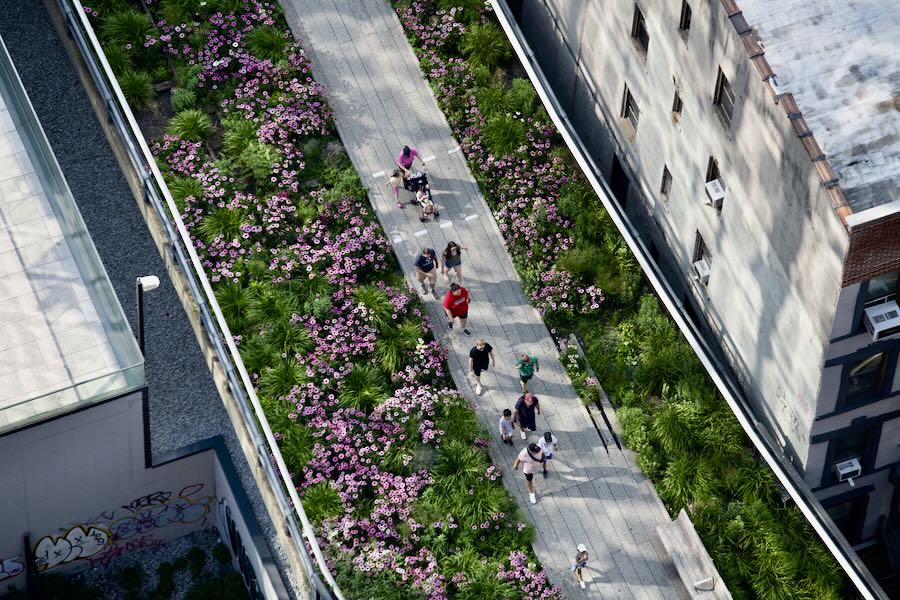
IT’S ONE of the best-known naturalistic gardens anywhere, and yet it’s perched in the most unnatural spot imaginable, 30 feet high above New York City traffic on an abandoned elevated railway line. The High Line on Manhattan’s West Side is celebrating the 15th anniversary of the opening of its first section, years that have been filled with expert lessons on gardening in this looser, nature-inspired style.
Today’s guest is Richard Hayden, the High Line’s senior director of horticulture. His team of 10 horticulturists manages the naturalistic gardens, originally designed by Piet Oudolf of the Netherlands, spanning portions of the 1.5-mile beloved park that welcomes about 7 million visitors a year. (Above, overhead photo by Timothy Schenck.)
Read along as you listen to the July 8, 2024 edition of my public-radio show and podcast using the player below. You can subscribe to all future editions on Apple Podcasts (iTunes) or Spotify (and browse my archive of podcasts here).
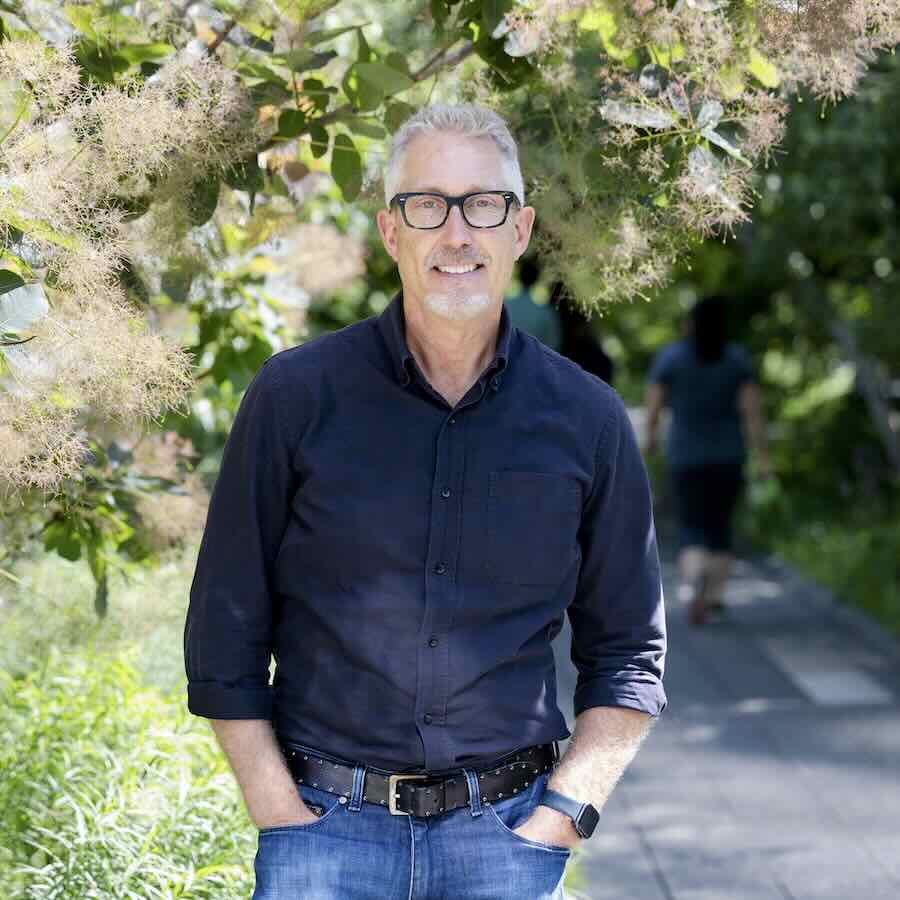
lessons in naturalistic gardening, with richard hayden
https://robinhoodradioondemand.com/podcast-player/38791/lessons-from-the-high-line-a-way-to-garden-with-margaret-roach-july-8-2024.mp3
Margaret Roach: So happy anniversary, birthday—whatever we want to call it, to you and the team.
Richard Hayden: Thank you.
Margaret: It was fun meeting some of you, at least virtually, to do a recent “New York Times” garden column together, which got a great response, which made me happy. So briefly, I think for people who are listening from all over the place who may not have visited, tell us the lay of the non-land over there [laughter]. I mean, it is a nutty setup when you think about it.
Richard: When you think about it altogether, the fact that it happened at all is sometimes a miracle. So of course, it was an unused, elevated railway on the West Side of Manhattan. And over the course of the 20 years that the trains weren’t running, seeds had drifted in and birds had probably dropped a few things off and soil had gotten created, and so this landscape had occurred.
And when the time came to consider what to do with it in the late ’90s, the idea that it could become a garden because people were up here looking at it in its wild state, and there were some amazing photographs taken by Joel Sternfeld of its wild state that it became this idea that it could be a garden. And Piet Oudolf was hired and Field Operations and Diller Scofidio + Renfro did some great designs.
And here we are 15 years later, and it is, I think one of the most important public gardens of the 21st century, because it changed the way we think about how we garden. It’s the four season garden. As Piet says, “a plant isn’t worth growing unless it looks good dead.” [Laughter.] And it’s true. It’s so beautiful here in the fall and in the winter, but it’s three-dimensional garden chess that he plays because each zone is slightly different.
And it gives you this emotionally evocative journey as you go from woodlands to grasslands and different combinations and complexities. And of course, all that complexity leads to biodiversity. We have many bees and birds and other animals that visit. So it’s just a really wonderful respite from the city.
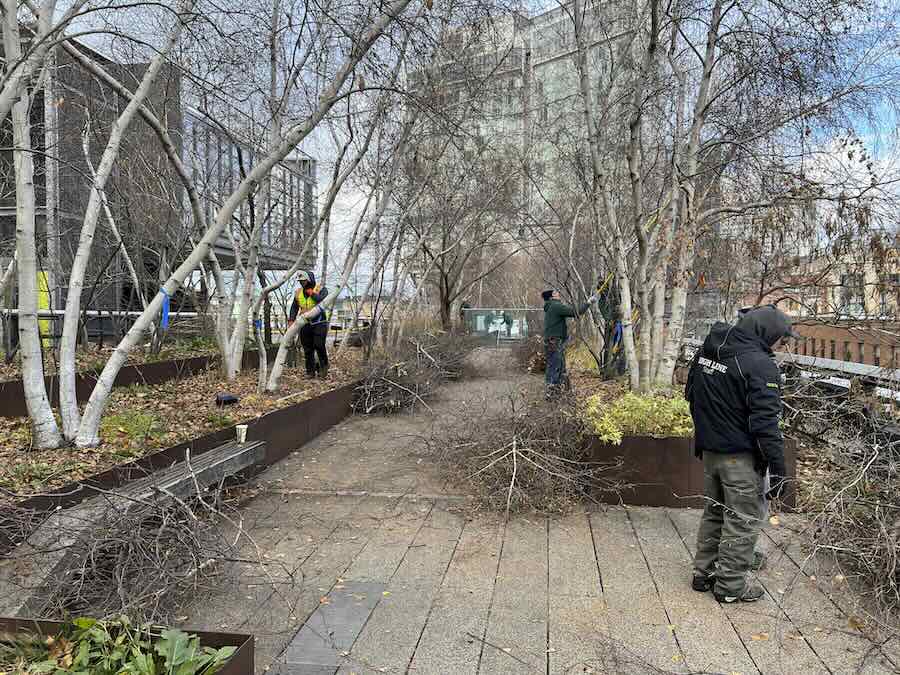
Margaret: And the thing that when we did the Times story that I just found when you first said it to me and I just can’t get over the idea of it, you have your soil depth up there and these beds that were built for this on this elevated railway, the soil is never what, more than 18 inches deep? I mean, it’s like raised beds [above, during pruning season; photo by Richard Hayden] on a raised railroad platform.
Richard: You’re right. It’s primarily 18 inches. There’s a couple spots where we’ve got some raised planters that we mound up and maybe get to 30 inches or so. And I have to tell you, when I first started, which was about a little over two and a half years ago, and I was seeing these 30-foot-tall birch trees and oak trees and all these big trees growing in 18 inches of soil, it literally kept me up at night. Every time the wind would blow…
Margaret: I would have a panic attack at the thought of it. Exactly.
Richard: And then I did some hiking in Northwest Connecticut on the Appalachian Trail, and there had been a windstorm, and these mature trees had blown over. And lo and behold, 18 inches of roots because of all of the glacial rock. The forest was literally growing in 18 inches of soil. And I thought, you know what? Mother Nature’s figured this out. I don’t have to worry so much.
Margaret: O.K., so you got started sleeping, good [laughter].
Richard: Yes, exactly.
Margaret: But it is. It’s really quite a feat and it’s great that it was inspired by that self-sown madness that had happened in this abandoned space.
Richard: Exactly, exactly, obviously with an artistic eye. And the problem with 18 inches is that it doesn’t… Because there can be warm air on top and warm air underneath, and cold air on top and cold air underneath, so we don’t have a lot of cushion.
Margaret: No.
Richard: So during heat waves, for instance, we have to be very careful to keep things with the right moisture levels. And then in the winter sometimes, we do lose a few things if we have a wet cold snap or something. So it does make challenges for that way.
Margaret: So Piet designed it in a naturalistic style, and he’s kind of the leader of that movement. But it doesn’t mean that it’s all native. And it also doesn’t mean, naturalistic doesn’t mean, like hands-off, let it do its thing; whatever happens, happens. It is a design. So let’s talk a little bit about that.
Richard: Right. So it is about 50 percent native. We did a wonderful hort celebration last year where we honored New York City native plants, and we found out we had 160 species that were native or known to be native to New York City out of the 500 or so species that we have. And they weren’t chosen because they were native, they were chosen because they’re just really good, resilient plants. So I was happy to do that discovery.
And Piet is very much about gardens are for people, and so natives are great, but sometimes there are bloom periods where the natives really aren’t filling the niche or maybe they don’t have enough winter structure. He’s happy to combine things as long as they are well-behaved, and we have a few that have not been so well-behaved. So it’s a learning curve.
Margaret: [Laughter.] Don’t we all, Richard? Don’t we all have a few of those?
Richard: Well, to be a successful plant on the High Line, you have to have a certain amount of resilience, a certain amount of aggression. And so a lot of what we do is manage those. We have a grass, Korean feather grass that was planted in one area, and I noticed in some photographs, in about three years after it was planted, it had been 20 percent of the mix. And three years later, it was 80 percent of the mix because it’s just such a virulent reseeder. That’s one of the things we have to do, is we have to manage those things that want to be too successful, so they don’t swallow their neighbors. Keep the balance.
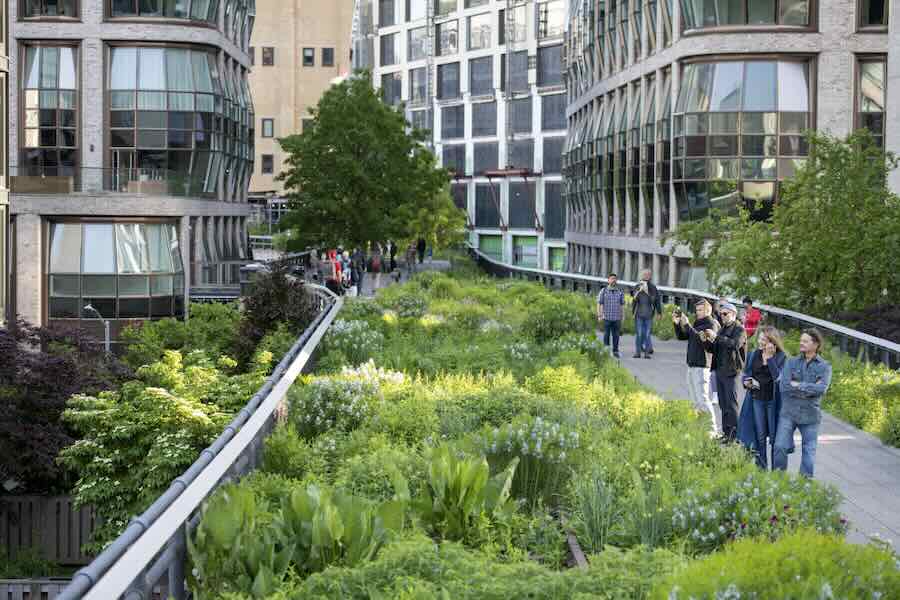
Margaret: Well, and so some of the tactics that he suggested in the initial design and that you and your team uphold and so forth to be naturalistic… I mean, for instance, there was one that really you guys talked to me about during the Times story interview, which, of course, it didn’t really occur to me. I wouldn’t have noticed it consciously, but there it is and it’s so obvious now that you have said it aloud to me.
When you have the garden on both sides of a path, that these drifts of plants that are on the one side also should sometimes be on the other side so that it looks as if the path was added through a natural area as opposed to… Yeah, this continuity as opposed to these are two separate gardens and here is my path, more manmade. And just these types of hints like that. Any others like that that you think about? Well, let’s talk about the drifts maybe because that’s an important aspect of his types of designs and naturalistic style. [Above, Timothy Schenck photo.]
Richard: Well, it’s interesting because it would be so easy to get these super complex gardens with lots of plants appearing all next to each other. But when you’re using nature as a model, nature has a tendency to not… I mean, it can be a very thick planting, but often it’s a repetition of a series of species. So that’s what Piet has replicated. He’ll choose what he calls his major accent plants. And then the High Line garden is actually what he would consider a matrix garden. So it’s a planting of a groundcover layer, often flowering.
So you can have things like autumn moor grass or catmint and other things that will just give you a basis a ground cover, and that’s the sort of thing that you’ll see often drifting on both sides of the path. And then into that are the larger perennials that occur in threes and fives and sevens. Always odd numbers for some reason, but it does always looks better. But he keeps it simple. By keeping the drifts large, it becomes a little bit more legible.
And then many of the new gardens that he does are actually block planting where it’s just series of blocks, obviously never a geometric shape, more of a tear shape or some sort of a more natural shape. But he does that quite frequently with his newer gardens, because it’s easier to take care of. You know what’s supposed to be where, what’s gotten out of balance.
Margaret: I see.
Richard: But here at the High Line, we’re a little bit more complex, so we’re constantly managing the dynamics of any one species. Some things they don’t succeed. We had a couple of plants. I’m very much into Helenium, and I’m forgetting common names.
Margaret: Sneezeweed [laughter].
Richard: Sneezeweed, right, yes, and they just never took. And of course, Piet doesn’t use a lot of red, and it’s kind of burgundy red, the one that he was suggesting here. I think it was ‘Moerheim Beauty.’ We just had to look for other things because it just was never happy.
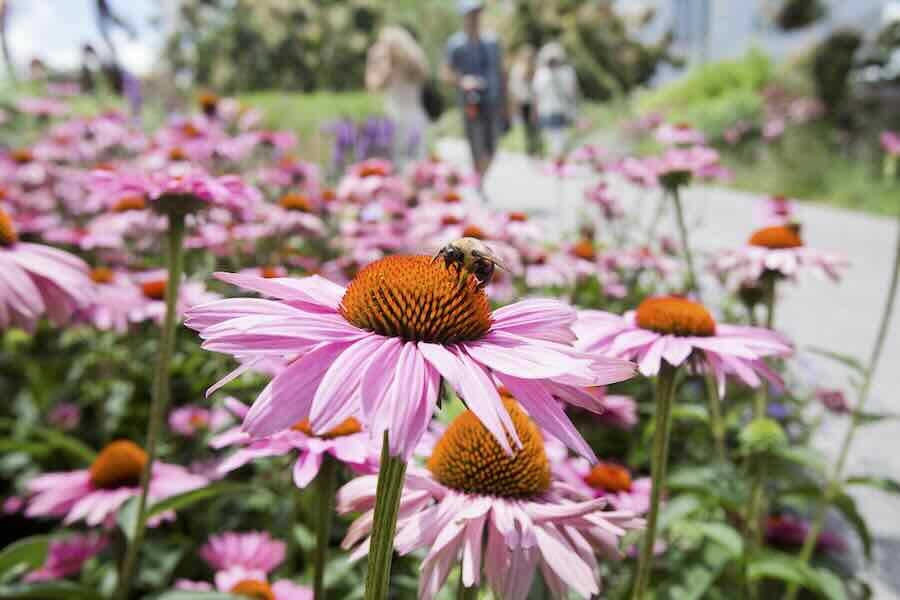
Margaret: In his original planting designs for the various garden areas at the High Line, he kind of narrows down… I mean, these are smaller spaces than nature, but he narrows down the number of key plants that we’ll be in, and he uses large numbers of each one in these drifts and these naturalistically shaped drifts. Because you don’t want it to just be a zillion polka dots all over the place of chaos. I mean, that’s not going to read, is it? [Above, Liz Ligon photo.]
Richard: No. And it’s just interesting we’re having this conversation, and I was just this morning laying out a Piet Oudolf design. We have a new plaza that’s going in at street level at 18th Street that’ll be the newest section of the High Line to open in September. And it’s the first time I’ve laid out a Piet design. And we were looking at the plans, and it really is, in this particular plan, big drifts of different kinds of grasses.
And then there’s geraniums coming in here and geums over here and agastaches over here. You get a better sense of really what he’s doing. This is the first time I’ve ever done it, but it’s really exciting to lay the garden out and you get a sense of really how his mind kind of works. You see the structure behind what he’s trying to do.
Margaret: I guess it was last year maybe he had a book come out that’s about his career, his projects, and there were a lot of his designs in it as part of the art in the book, not just photographs. And you can see that there, too. You can see these shapes and the plants that are specified to go in each one and so forth.
The other thing I find interesting about the drifts is it pleases our eye, and it works in this style to do it that way. But in nature, if you had just onesies of a million different things, the animals, especially the insects who are dependent on these plants, couldn’t find them and couldn’t utilize them in the same way. So the drifts also serve a purpose, do you know what I mean, in nature, in the natural world.
Richard: Absolutely.
Margaret: These plant communities are not just a million different kinds of plants all crunched together. There are a few key plants in larger numbers.
Richard: And in more of the grassland plantings, for instance, he’s relying on certain plants to have the structure to hold other plants up, which is what, of course, happens in their natural environments as well.
Margaret: Yeah, the meadows and prairies are really grasslands.
So I’m told by a lot of people who have tried to or who have gone more naturalistic in some area of their gardens, maybe made a small meadow or whatever, I hear, “Well, but it keeps changing. It doesn’t look like the original plan. It’s not how I imagined it.” [Laughter.] “It doesn’t look like the picture in the book,” when they bought it from a catalog, they bought the seed or the plugs or whatever.
That’s sort of that, oops, hello succession, natural succession: the way things go in nature. And so let’s talk a little bit about that, because this is something that the High Line 15 years on, or any naturalistic garden even five years on doesn’t look exactly like the plan, even if it was a Piet plan [laughter].
Richard: Correct. And Piet always says a garden’s never done. And it is an evolution. And the garden will tell you what it wants to become. And so when we are the stewards of these naturalistic landscapes, we’re interrupting the succession, the succession being the natural world is moving from a grassland to a mature forest. And that’s generally the course of the evolution of planting. And so we get to step in and say we want to keep it as a grassland, and so we need to make these interventions.
We need to make substitutions for the plants that aren’t working. We need to edit out the ones, the thugs, if you will, that get too happy. We get to be completely surprised by the serendipity of something seeding in, or the combination that you really weren’t certain of, but it’s kind of rearranged itself in the way that some of the things have seeded. It’s being awake to how the garden wants to mature, and hopefully having a somewhat light touch on making sure that you get something that’s pleasing and you’re making the right combinations be successful.
Margaret: But it is a lot of editing. I mean, it’s not just stepping back and going, “O.K., that’s done. It’s been planted. All finished. On to the next project.” It’s not that at all.
Richard: No. And some things literally are meant to be fillers in an early planting. And then once the grasses get established, they will want to become 80 percent of your meadow. And so you have to maybe have strategies for removing a few, some of the taller grasses, the giant… Is it giant bluestem?
Margaret: Little bluestem and… I don’t know what you call the big one, but yeah.
Richard: Big bluestem. Which left to its own devices was at one point crowding out the pathway. And so we have to go in and say, you know what? You’re great. We need you in the back. We need you a little bit more as a punctuation rather than as a solid wall. And so that’s where a lot of the editing comes in.
Margaret: Because you were just saying the different plants and how they almost have a life cycle, certain plants in these designs, and some are almost used as nurse crops, what you might call nurse crops, in the beginning to fill space with something other than weeds that might come up from the soil. So some of your biennials and so forth, they’re not going to last five or 10 years [laughter]. They’re not going to be there because as you point out, the grasses and other things will have filled in.
Those things that are dependent on self-sowing aren’t going to have as many opportunities to reach bare soil anymore and their life cycle will be over from those original plants. So your black-eyed Susans or whatever that you who were like, “Oh, look, there’s so many of those. They look so pretty,” Well, that may not happen in year 3 or 4 or 5 or 10.
Richard: Right. This morning I was placing Oriental poppy, which we don’t have on the High Line. It was one of the original plants that were spec’d, but it’s one of those early interesting flower plants to come up between the small grasses for the first two or three years. They’re not terribly long-lived in my experience, anyway, so it’s just one of those let’s create some interest.
We had the same with… Is it foxtail Lily? Eremurus, yes. The same thing. Really successful, a wonderful High Line plant in the first five years, but now it’s been crowded out by grasses. We tried to get it established again, and it’s a tricky one. It’s one of those so used to having expert drainage and hot, dry places. You make sacrifices. You say, well, that was great in the beginning and now we’ll move on to let the garden have some other aspect that’s going to shine.
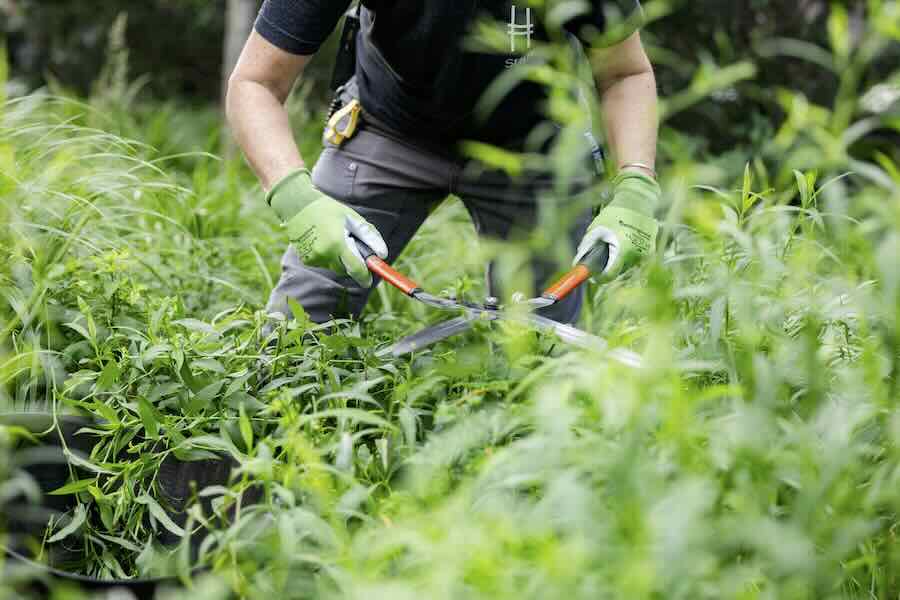
Margaret: Right. So another form of editing, a lot of people have heard of the Chelsea chop, the timed and named for the Chelsea Flower Show in England, because in late May, certain kinds of perennials are cut back part way. And doing that, they’re bushier and maybe they start blooming a little later, but they’re fuller and so forth.
You kind of take it to an extreme up there [laughter]. You guys have got Chelsea chops going on. Just tell me a little bit about that method of editing the pictures. [Above and below, hedge clippers are used on drifts deeper in the borders; pruning shears on plants closer to the paths. Liz Ligon photos.]
Richard: Well, I think it primarily comes from the aspect like we have so many plants, and the gardens are so full; we don’t have the ability to stake anything. Asters in the tall grass prairie like Chelsea Grasslands [part of the High Line] will do O.K. with just one chop where we’ll hit them pretty much in late May, early June, right around the Chelsea Flower Show. But we have I think it’s Aster October Skies that are peppered throughout the Gansevoort Woodlands of the Birch Woodlands down here at the south end of the park.
Because they’re in more shade and they can get floppy, I think John [Gunderson] cuts those two or three times. So now I think they did them in late May, again in June, and then he’ll do another cut probably in mid-July. And they’ll bloom later, but they’ll also be beautiful, bushy, just probably 12 to 18 inches tall rather than the 30 or 36 inches that they would flop over if they were left to their own devices. We do that a lot with plants. I think Nepeta, some Monarda have been done occasionally.
Margaret: I bet goldenrods too.
Richard: Solidago, and some of the Coreopsis, too, I think, we hit.
Margaret: Again, it gives you, without staking or anything like that, which would just be impossible, it gives you a bushier plant, which is great and needed. Otherwise you can have a lot of floppy things, especially as you point out in the shady areas. You have a lot of that going on. And I imagine that you do some thinning also, because you have a lot of wind, don’t you?
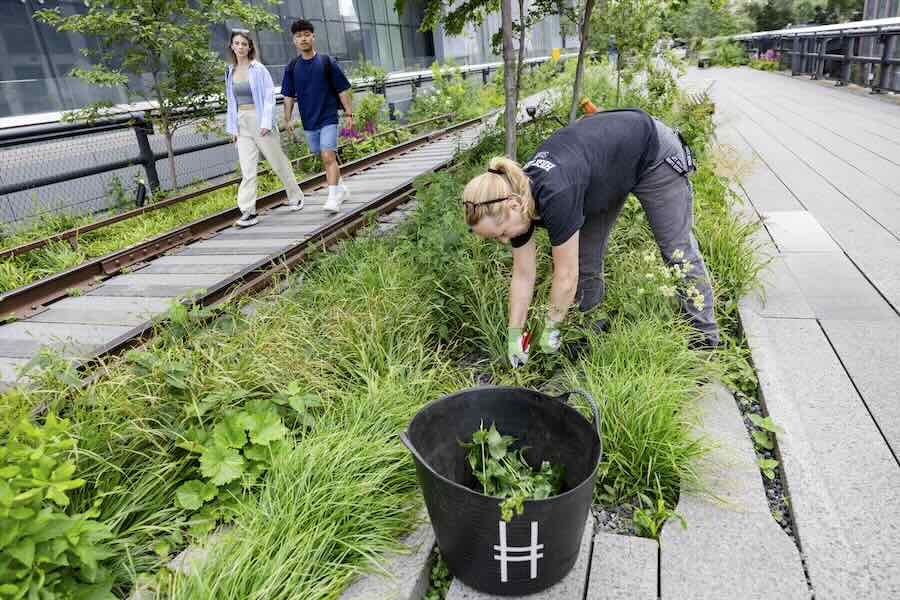
Richard: My gosh, yes. In fact, it was quite windy this morning, and lovely wind because it was low-humidity wind for a change. But I know that on some of the Joe-Pye weeds, for instance, which can get rather dense and tall, those can be very affected. We do it also with Baptisia, the false indigos.
Margaret: Sure.
Richard: So there are some of the larger flowering perennials that really need to be in the windier spots do need to be thinned out so they don’t create too much sail.
And of course, we do that with all of our trees as well. We keep all of the birch trees and the oaks and everything pretty well laced out to make sure that we’re getting a lot of good dappled light on the understory, because we are known for having this complex tree canopy, flowering spring trees, maybe the Amelanchier or the redbuds, and then the groundcover layer.
And all of that coexists, and that’s what I think makes the High Line such a great place to visit because the gardens are so intense, and you have all those different layers. But it just takes a lot of management to make sure everything stays happy.
Margaret: Right, right. Yeah, it’s a lot. [Laughter.] It’s definitely, definitely a lot. But you were just talking about pruning essentially the trees. And the fact that what all of us confront, speaking of things that change in a garden, no matter whether we’re managing it naturalistically or not, is usually less light, because our trees and shrubs grow as we’re there for longer. And so sometimes there’s the hard decision to even remove a woody plant, because it’s surviving at the expense of, as you’re pointing out, like the groundcover layer or whatever.
There’s just not the light that there was, and everything else is suffering. That’s a really tricky one. But again, no matter what your style or your design aesthetic, that’s one that gardeners face who stay put for a long time and making shrubs grow, right?
Richard: Yes. And it’s not a light decision that we make to thin trees out. But I think people were surprised how well trees actually did on the High Line. I don’t think they expected them to get quite so tall and quite so full. So it’s easier to say it’s just getting too crowded in this space. The easiest thing to do, rather than try to manipulate every single tree into being just the right amount of open, we can selectively take out a tree here or there and open things up. And it looks more natural, frankly.
You can think about getting that next succession, those younger trees growing in your woodland, so it feels a little bit more natural, and then you’re planning for succession. Because if all the trees are 20 years old, all the trees are potentially going to fail at the same time. So now we’re thinking about getting some smaller trees in this fall. So we have this different age level.
And in areas like the Flyover, which is the area people may be familiar with with the elevated walkway, there we’re frankly getting quite a bit of reseeding. Well, the sassafras come up everywhere, but the magnolias, the big-leaf magnolias are self-seeding. Some of the sweetbay magnolias are also self-seeding. So we’re leaving those and we get to select out. And even in our bur oak grove, we have some seedlings that we’re going to leave, so we’ll have different ages. And so it just is creating that, thinking about what is going to be successful in five or 10 years. It’s just planning ahead.
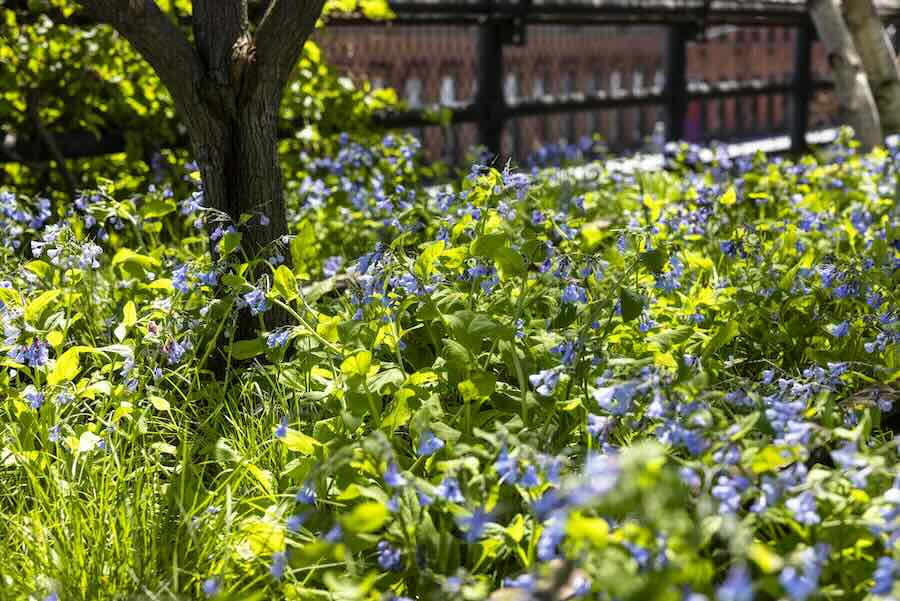
Margaret: I just wanted to ask an adjunct to one of the things we were talking about before with self-sowns. Even ones that are spec’d in the plan and the design, even ones that you love. I think John, who you referred to before, John Gunderson, one of your senior gardeners, he has a lot of Virginia bluebells, Mertensia virginica, in his area [above; photo by Andrew Frasz]. And there can be too much of a good thing, right? It can self-sow too much and distort the look. So sometimes you’re taking out things that are desirable but not in excess. Is that another mandate?
Richard: Yes, exactly. The Mertensia is one of the situations where it’s great where we have it and it looks so natural the way it occurs in these big drifts that go across the pathway, but John does do some seedhead chopping. And then of course, it does need a cleanup in the spring because the leaves as they are fading back don’t look so great. Often Piet’s really good about… If he’s using ephemerals and bulbs and things like that, he’ll have a plant that will be growing up to hide the leaves that are yellowing.
He’s quite good about that combination. I know, for instance, we have quite a bit of Chasmanthium, the Northern sea oats, and we’ve noticed that reseeds quite a bit. As much as we are the garden that you should come to see because we have these beautiful seeds in the winter, we do selectively reduce some of the seeds just so we don’t end up with too many plants.
Margaret: Exactly. It’s tough, and especially on newer gardeners, it’s tough because no one wants to get rid of anything, or compost anything, or throw anything away, so to speak. And it’s tough. It’s a tough decision. Well, the High Line, I think your gardeners told me that best times to visit are between 7:00 and 9:00 AM. [Visiting information.]
Richard: Oh my gosh, we do get very crowded because we’re very popular and that’s great. But if people really want to have an experience, come between 7:00 and 9:00 AM, or even in the evenings, we’re open in the evenings in the summertime. That’s lovely. We’re open until 10:00 PM.
Margaret: Wow!
Richard: And it’s an interesting experience at night. All the plants are low-lit, so you can experience the… But really the morning is when it’s magic.
Margaret: Well, Richard Hayden, thank you for making time. I know you got to get down there to 18th Street and go figure out that planting layout before it gets away from you.
prefer the podcast version of the show?

MY WEEKLY public-radio show, rated a “top-5 garden podcast” by “The Guardian” newspaper in the UK, began its 15th year in March 2024. It’s produced at Robin Hood Radio, the smallest NPR station in the nation. Listen locally in the Hudson Valley (NY)-Berkshires (MA)-Litchfield Hills (CT) Mondays at 8:30 AM Eastern, rerun at 8:30 Saturdays. Or play the July 8, 2024 show using the player near the top of this transcript. You can subscribe to all future editions on iTunes/Apple Podcasts or Spotify (and browse my archive of podcasts here).
Source: awaytogarden.com

Leave a Reply